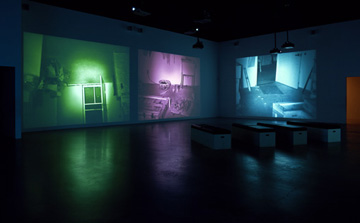
Bruce Nauman, "Mapping the studio II with color shift, flip, flop, & flip/flop (Fat Chance John Cage)," 2001
Not all events are recorded equally. Despite YouTube’s diarrheic explosion of what constitutes a potential video, clips where almost nothing happens are still difficult for a lot of people to get behind. Sometimes video is difficult when it’s not entertaining, but entertainment is not something most disciplines in art are ever expected to be. Nobody expects Robert Ryman to be funny, or captivating.
The first generation of artists working in video seemed to understand the revolutionary potential of the medium. Such pioneers as Peter Campus, Nam June Paik, Steina and Woody Vasulka, VALIE EXPORT, or Bruce Nauman (among a multitude of others…) explored how video recording technologies changed the audience’s perception of time, space and the body by making them confront how their video image manipulated these concepts to make them their time, their space, their body. Despite the physical separation between the machine and the human, video does indeed control our “nerve endings.”
To me, the idea of the cyborg is more interesting as a way to mark a certain symbiosis with technological systems that we have created to enhance the abilities of our organic bodies. A few months ago, I wrote about the concept of the Kino-Eye as a proto-cyborg, explaining how video technologies have extended what is humanly possible for us to see with the “hardware” we are born with. As we move into a future that is quickly becoming hyper-mediated by video (you can get a smart phone with AVATAR pre-loaded on it!), it becomes difficult to ignore the fact that all these moving images are changing the way our brains work, and how we respond to recorded events.
I recently finished reading Michael Chorost’s Rebuilt: How Becoming Part Computer Made Me More Human, a memoir about his hearing loss and the subsequent “reconstruction” of it via a cochlear implant. It’s a great read and I highly recommend it, but there are a few assertions Chorost makes that rubbed me the wrong way. The main point of contention I find is his strictness in defining what a cyborg is:
To be meaningful and useful, then, the word cyborg has to do something new. It has to name a kind of relationship with technology that has not existed before. Mediating a person’s perception of reality by computationally controlling nerve endings inside the body is most definitely new. Glasses don’t do that; cell phones don’t do that; even pacemakers don’t do that. But a cochlear implant does.
As an alternative term, Chorost proposes fyborg, or “functional cyborg,” a portmanteau of a portmanteau attributed to Gregory Stock’s book Redesigning Humans. The difference, Chorost writes, is that “fyborgs are augmented by externally worn equipment, whereas cyborgs are physically fused with the equipment.”
Chorost’s point is valid, to be fair, but rests on what I perceive to be a narrow understanding of the terminology he is using. A “cyborg” is a “cybernetic organism,” which may or may not be human. According to the Oracle (Wikipedia), the term “was coined in 1960 when Manfred Clynes and Nathan Kline used it in an article about the advantages of self-regulating human-machine systems in outer space.” For someone whose bodily borders have been transgressed so many times (by the rubella that damaged his hearing in utero, by the cochlear implant, by software upgrades, etc), Chorost’s definition sure is precious about his physical unity.
Obviously, a big part of this disagreement lies with the different definitions of a term like “cyborg.” The meaning with which this word is conferred varies vastly depending on from which vantage point it is being looked. A biomedical engineer will probably have a very different idea of what a cyborg is than a queer studies professor or a Comic-Con regular.
So let’s talk about Bruce Nauman. In his video installation, Mapping the studio II with color shift, flip, flop, & flip/flop (Fat Chance John Cage) from 2001, Nauman trains seven cameras on areas of his studio where mice could be seen moving about. Then, he recorded everything that happened overnight. At first it seems like a whole lot of nothing. But upon closer viewing, things start to happen. You see a mouse, an insect, Nauman’s cat. Sure, the pacing is glacially slow, but what Nauman is asking of his audiences is for them to shift how they perceive time, movement, contingency. Nauman’s ability to see and hear what happens in his studio when he isn’t there, when he isn’t even awake, and to share this reordering of sensory experience is, to quote Chorost, “most definitely new” from an evolutionary perspective. Nauman’s video projections, like Chorost’s electronic “hearing,” both constitute a reorganization of the brain’s “input” structures through technological means.
To return to the title of Chorost’s book, does becoming part computer make us more human? Extending that, does Nauman’s ability to experience sight and hearing at a distance and through time make him more human? Does a visitor to Mapping the studio II with color shift, flip, flop, & flip/flop (Fat Chance John Cage) become more human? Moreover, is becoming more human a laudable pursuit? Perhaps becoming more than human might be more fun…




Pingback: reading list | POSTstudio